Megaherb

Megaherbs are a group of herbaceous wildflowers growing in the New Zealand subantarctic islands and on the other subantarctic islands. They are characterised by their great size, with huge leaves and very large and often unusually coloured flowers, which have evolved as an adaptation to the harsh weather conditions on the islands. They suffer from overgrazing due to introduced mammals.
Appearance and occurrence[]

Originally, the term was coined to describe large-leaved herbs that form meadows in the subantarctic islands[1] but has also been applied to describe tropical alpine vegetation forms[2] found in the Andes, East Africa and New Guinea.[3] They are large herbs that can reach dimensions of over one metre, often feature strikingly colourful flowers,[4][5] and are important components of the ecosystems of the subantarctic islands.[6] Some genera have perennial leaves and others are deciduous.[7] Intensely coloured flowers are not unique to megaherbs but also occur on other plant species in the same environments[8] and either arose by chance or are evolutionary adaptations to the environment.[9]
They live in the wet, windy and cold environments of the subantarctic islands, where they coexist with cushion plants and tussock grasses but trees are absent. A single species, Pleurophyllum hookeri, covers almost a third of Macquarie Island[10] where another megaherb, Stilbocarpa polaris, also occurs.[11] They reach their maximum extent on that island.[12] On Campbell Island they appear to occur preferentially in nutrient-rich (eutrophic) terrain. Researchers since the 1940s often incorrectly assumed that they are limited to cliffs and ledges, as grazers had extirpated them from other areas.[13]
The most extraordinary of the megaherbs is the Pleurophyllum meadow, a community dominated by the large-leafed herbaceous composite, producing a floral display second to none outside the tropics
— Joseph Dalton Hooker, quoted in Fell, 2002[1]
They are the best known plants of the New Zealand subantarctic islands[14] and are important components of the biodiversity of the region.[2] Another name is "megaphyllous herbs".[3]
Taxa[]
In the New Zealand subantarctic islands, four endemic genera make up megaherbs. Among these are Anisotome and Bulbinella with colourful flowers and Pleurophyllum and Stilbocarpa with large leaves.[14][15] Additional genera are Gentianella[16] and Pringlea.[6]
The Chatham Island forget-me-not (Myosotidium hortensia) naturally occurs on the Chatham Islands but has been brought to New Zealand. It has large leaves and forms rosettes up to one metre wide.[17] The Kerguelen cabbage (Pringlea antiscorbutica) is a megaherb species that occurs on Heard Island where it is a key species in herbfields, Iles Crozet, Iles Kerguelen, Marion Island and Prince Edward Island.[18]
Other species called "megaherbs" include Phormium colensoi on New Zealand.[19] The Mountain buttercup (Ranunculus lyallii) is also considered a megaherb[20] and has been referred to as one.[21] The species , Bulbinella rossii, Myosotidium hortensia, Pleurophyllum spp. and Stilbocarpa in the Chatham Islands have been referred to as "macrophyllous forbs".[22]
Evolutionary history and ecology[]
The origins of the megaherb growth form are enigmatic. Several different subantarctic genera independently evolved this trait, which is defining for the genus Pleurophyllum.[15] Stilbocarpa megaherbs evolved from ancestors with smaller leaves.[23] These plants survived the last glacial maximum on the subantarctic islands and spread northward after its end.[24] Related species also occur on New Zealand.[25]
Megaherbs have been described as a form of gigantism.[16] The evolution of the megaherb form may be a consequence of specific conditions in the subantarctic islands.[15][4] The large leaves could be intercepting nutrient-bearing aerosols and trap heat in cold environments. Rosette growths reduce wind speeds and wind-driven evaporation and cooling.[25] The leaves may also act to absorb heat from [13] and higher temperatures have been measured in megaherbs than the surrounding environment.[26] At the same time, the lack of herbivores, plentiful water and nutrients brought by e.g seabirds and steady temperatures facilitate the growth of large plants.[23] On Adams Island megaherbs are well developed where they are fertilized by guano. In return, birds use them as cover and source of insects[27] and are burrowed by nesting birds.[28] Such burrowing may influence the establishment of megaherb communities.[29] They are among the first plants to resettle former albatross nests on Adams Island.[30] The simultaneous occurrence of large leaves, large underground storage tissues, large seeds and large seed output is also found in megaherbs and appears to reflect unusual adaptations, as resource trade-off would normally prohibit their simultaneous occurrence.[6]
Herbs with large leaves occur in other places such as Chile, Hawaii, Kenya and New Zealand but there are traits specific for subantarctic megaherbs[31][24] and there are environmental differences, such as lower and more steady insolation.[32] Their evolution may be driven by similar environmental factors that are encountered on high mountains and in polar climates,[23] such as cold and windy weather, and may thus be examples of convergent evolution.[33]
Wētā, flightless crickets of New Zealand, have been observed to pollinate megaherbs and may constitute their main pollinators.[34] Moths have also been observed pollinating megaherbs.[35]
Human history[]
Megaherbs were first described by the British botanist Joseph Dalton Hooker, who coined the term in 1847.[1] The Fairchilds Garden site on Adams Island was noted already in 1891 for its megaherbs.[27] The characteristic appearance makes Pleurophyllum a plant that could be used in horticulture, but attempts to cultivate it outside of the subantarctic environment have largely been unsuccessful.[15]
Threats[]
Megaherbs are susceptible to overgrazing by mammals.[13] Feral pigs have devastated megaherb communities on Auckland Island.[36] On Macquarie Island, rabbits consume megaherbs while rats cache seeds of Pleurophyllum hookeri[37] in places unsuited for their germination,[38] and the growth of the rabbit population has resulted in a major reduction of megaherb populations, as well as of other plant taxa of the island.[39]
Where grazing animals have been removed, megaherb species often quickly reoccupy the terrain.[25] This is expected to occur on Macquarie Island after rabbit and rodent populations[40] began to shrink since 2010. They will probably displace less edible but also less competitive plant species like Agrostis magellanica and Acaena magellanica.[37] Conversely only a partial recovery took place on Campbell Island by 1994.[41]
Other uses of the term[]
The term "megaherb" has also been used to describe heliconiaceae, which are tropical species,[42] and for the Amazonian species Phenakospermum guyannense.[43]
Gallery[]

Bulbinella rossii, Stilbocarpa polaris, and two species of Pleurophyllum
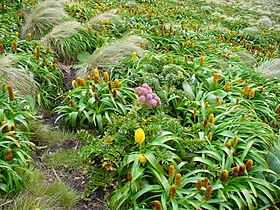
B. rossii, Anisotome latifolia, and Pleurophyllum

B. rossii
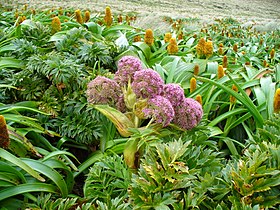
A. latifolia and B. rossii

Pleurophyllum speciosum, the Campbell Island daisy

Pleurophyllum hookeri and B. rossii
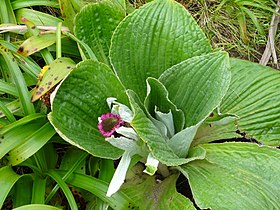
A hybrid between P. hookeri and P. speciosum
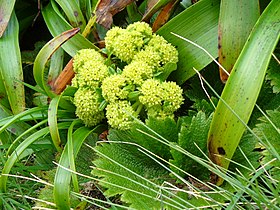
S. polaris and B. rossii
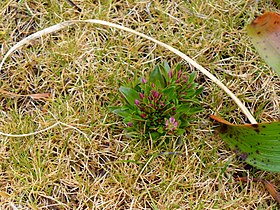
See also[]
References[]
- ^ a b c Wagstaff, Breitwieser & Ito 2011, p. 63.
- ^ a b Shaw, Hovenden & Bergstrom 2005, p. 118.
- ^ a b Mark, Dickinson & Hofstede 2000, p. 251.
- ^ a b Komai & Emura 1955, p. 87.
- ^ MEURK, FOGGO & WILSON 1994, p. 161.
- ^ a b c Convey, P.; Chown, S. L.; Wasley, J.; Bergstrom, D. M. (2006). "Life History Traits". Trends in Antarctic Terrestrial and Limnetic Ecosystems: Antarctica as a Global Indicator. Springer Netherlands. p. 107. ISBN 978-1-4020-5277-4.
- ^ Wagstaff, Breitwieser & Ito 2011, p. 71.
- ^ Lord et al. 2013, p. 169.
- ^ Lord et al. 2013, p. 170.
- ^ Briggs, Selkirk & Bergstrom 2006, p. 187.
- ^ Briggs, Selkirk & Bergstrom 2006, p. 188.
- ^ Fernández-Palacios, José María (2009). Encyclopedia of islands. Berkeley. p. 574. ISBN 9780520943728.
- ^ a b c MEURK, FOGGO & WILSON 1994, p. 162.
- ^ a b "Plants on New Zealand's subantarctic islands". Department of Conservation. New Zealand Government. Retrieved 21 June 2021.
- ^ a b c d Wagstaff, Breitwieser & Ito 2011, p. 70.
- ^ a b Wallis, Graham P.; Trewick, Steven A. (2009). "New Zealand phylogeography: evolution on a small continent". Molecular Ecology. 18 (17): 3552. doi:10.1111/j.1365-294X.2009.04294.x. ISSN 1365-294X.
- ^ "Chatham Island forget-me-not". Department of Conservation (New Zealand). New Zealand Government. Retrieved 21 June 2021.
- ^ Schortemeyer, Marcus; Evans, John R.; Bruhn, Dan; Bergstrom, Dana M.; Ball, Marilyn C. (2015-04-17). "Temperature responses of photosynthesis and respiration in a sub-Antarctic megaherb from Heard Island". Functional Plant Biology. 42 (6): 553. doi:10.1071/FP14134. ISSN 1445-4416.
- ^ Stowe, C. J.; Kissling, W. D.; Ohlemüller, R.; Wilson, J. B. (2003-12-01). "Are ecotone properties scale-dependent? A test from a Nothofagustreeline in southern New Zealand". Community Ecology. 4 (1): 36. doi:10.1556/ComEc.4.2003.1.4. ISSN 1588-2756.
- ^ Mark, Dickinson & Hofstede 2000, p. 245.
- ^ Smale, Mark C.; Wiser, Susan K.; Bergin, Michael J.; Fitzgerald, Neil B. (2018-01-02). "A classification of the geothermal vegetation of the Taupō Volcanic Zone, New Zealand". Journal of the Royal Society of New Zealand. 48 (1): 29. doi:10.1080/03036758.2017.1322619. ISSN 0303-6758.
- ^ McGlone, M.S. (February 2002). "The Late Quaternary peat, vegetation and climate history of the Southern Oceanic Islands of New Zealand". Quaternary Science Reviews. 21 (4–6): 686. doi:10.1016/S0277-3791(01)00044-0. ISSN 0277-3791.
- ^ a b c Mitchell, Anthony D.; Meurk, Colin D.; Wagstaff, Steven J. (1999-06-01). "Evolution of Stilbocarpa, a megaherb from New Zealand's sub‐antarctic islands". New Zealand Journal of Botany. 37 (2): 209. doi:10.1080/0028825X.1999.9512628. ISSN 0028-825X.
- ^ a b Wagstaff et al. 2007, p. 7.
- ^ a b c Komai & Emura 1955, p. 91.
- ^ Nagaoka, Nobuyuki; Naoe, Shoji; Takano-Masuya, Yu; Sakai, Shoko (2020-10-14). "Green greenhouse: leaf enclosure for fruit development of an androdioecious vine, Schizopepon bryoniifolius". Proceedings of the Royal Society B: Biological Sciences. 287 (1936): 6. doi:10.1098/rspb.2020.1718.
- ^ a b Elliott et al. 2020, p. 157.
- ^ Elliott et al. 2020, p. 166.
- ^ Rexer-Huber, Kalinka; Thompson, David; Parker, Graham; Parker, Graham (2020). "White-chinned petrel (Procellaria aequinoctialis) burrow density, occupancy, and population size at the Auckland Islands". Notornis. 67 (1): 397.
- ^ Elliott et al. 2020, pp. 163–164.
- ^ Komai & Emura 1955, p. 90.
- ^ Little et al. 2016, p. 9.
- ^ Little et al. 2016, p. 2.
- ^ Lord et al. 2013, p. 178.
- ^ Buxton, Max N.; Anderson, Barbara J.; Hoare, Robert J. B.; Lord, Janice M. (2019-12-12). "Are moths the missing pollinators in Subantarctic New Zealand?". Polar Research. doi:10.33265/polar.v38.3545. ISSN 1751-8369.
- ^ "Zero Pigs". Department of Conservation (New Zealand). New Zealand Government. Retrieved 22 June 2021.
- ^ a b Tasmanian Government 2021, p. 2.
- ^ Shiels, Aaron B.; Pitt, William C.; Sugihara, Robert T.; Witmer, Gary W. (April 2014). "Biology and Impacts of Pacific Island Invasive Species. 11. Rattus rattus, the Black Rat (Rodentia: Muridae)". Pacific Science. 68 (2): 155. doi:10.2984/68.2.1. ISSN 0030-8870.
- ^ Marchant, R.; Kefford, B. J.; Wasley, J.; King, C. K.; Doube, J.; Nugegoda, D. (2011-04-28). "Response of stream invertebrate communities to vegetation damage from overgrazing by exotic rabbits on subantarctic Macquarie Island". Marine and Freshwater Research. 62 (4): 405. doi:10.1071/MF10317. ISSN 1448-6059 – via CiteSeer.
- ^ Tasmanian Government 2021, p. 1.
- ^ MEURK, FOGGO & WILSON 1994, p. 148.
- ^ Fleming, Theodore H.; Kress, W. John (2013-10-03). Appendix 2. Overview of the Major Families of Plants containing Species That Are Pollinated or Dispersed by Birds or Mammals. University of Chicago Press. p. 498. doi:10.7208/9780226023328-013.
- ^ Fleming, Theodore H.; Geiselman, Cullen; Kress, W. John (November 2009). "The evolution of bat pollination: a phylogenetic perspective". Annals of Botany. 104 (6): 1025. doi:10.1093/aob/mcp197. PMC 2766192.
Sources[]
- Briggs, C. L.; Selkirk, P. M.; Bergstrom, D. M. (2006-01-01). "Facing the furious fifties: The contractile stem of the subantarctic megaherb Pleurophyllum hookeri". New Zealand Journal of Botany. 44 (2): 187–197. doi:10.1080/0028825X.2006.9513017. ISSN 0028-825X.
- Elliott, Graeme; Walker, Kath; Parker, Graham; Rexer-Huber, Kalinka; Miskelly, Colin; Miskelly, Colin (2020). "Subantarctic Adams Island and its birdlife". Notornis. 67 (1): 153–187.
- Komai, Taku; Emura, Shigeo (1955). "A Study of Population Genetics on the Polymorphic Land Snail Bradybaena similaris". Evolution. 9 (4): 400–418. doi:10.2307/2405475. ISSN 0014-3820.
- Little, Lorna; Eidesen, Pernille Bronken; Müller, Eike; Dickinson, Katharine J. M.; Lord, Janice M. (2016-01-01). "Leaf and floral heating in cold climates: do sub-Antarctic megaherbs resemble tropical alpine giants?". Polar Research. 35 (1): 26030. doi:10.3402/polar.v35.26030.
- Lord, J. M.; Huggins, L.; Little, L. M.; Tomlinson, V. R. (2013-09-01). "Floral biology and flower visitors on subantarctic Campbell Island". New Zealand Journal of Botany. 51 (3): 168–180. doi:10.1080/0028825X.2013.801867. ISSN 0028-825X.
- Mark, Alan F.; Dickinson, Katharine J. M.; Hofstede, Robert G. M. (2000-08-01). "Alpine Vegetation, Plant Distribution, Life Forms, and Environments in a Perhumid New Zealand Region: Oceanic and Tropical High Mountain Affinities". Arctic, Antarctic, and Alpine Research. 32 (3). doi:10.1080/15230430.2000.12003361. ISSN 1523-0430.
- MEURK, COLIN D.; FOGGO, M.N.; WILSON, J. BASTOW (1994). "THE VEGETATION OF SUBANTARCTIC CAMPBELL ISLAND". New Zealand Journal of Ecology. 18 (2): 123–168. ISSN 0110-6465.
- Shaw, Justine D.; Hovenden, Mark J.; Bergstrom, Dana M. (2005). "The impact of introduced ship rats (Rattus rattus) on seedling recruitment and distribution of a subantarctic megaherb (Pleurophyllum hookeri)". Austral Ecology. 30 (1): 118–125. doi:10.1111/j.1442-9993.2005.01430.x. ISSN 1442-9993.
- Tasmanian Government (2021). "The Vegetation Communities: Macquarie Island vegetation" (PDF). Department of Primary Industries, Parks, Water and Environment. From Forest to Fjaeldmark (2 ed.). Retrieved 22 June 2021.
- Wagstaff, Steven J.; Breitwieser, Ilse; Ito, Motomi (2011). "Evolution and biogeography of Pleurophyllum (Astereae, Asteraceae), a small genus of megaherbs endemic to the subantarctic islands". American Journal of Botany. 98 (1): 62–75. doi:10.3732/ajb.1000238. ISSN 1537-2197.
- Wagstaff, Steven J.; Breitwieser, Ilse; Quinn, Christopher; Ito, Motomi (2007-10-29). "Age and origin of enigmatic megaherbs from the subantarctic islands". Nature Precedings: 1–1. doi:10.1038/npre.2007.1272.1. ISSN 1756-0357.
External links[]
- Article on a recent botanic expedition to Campbell Island to view megaherbs
- Photograph of megaherb community on Enderby Island, one of the Auckland Islands
- Another megaherb photograph, Enderby Island
- Another megaherb photograph, Campbell Island
- Another megaherb photograph, Campbell Island
- Megaherb photoset on Flickr
- Flora of New Zealand









